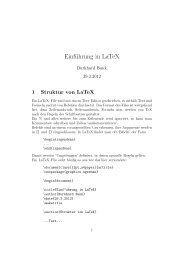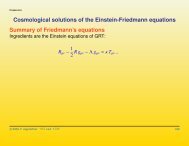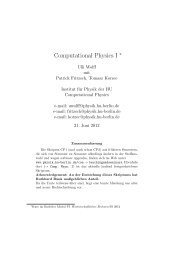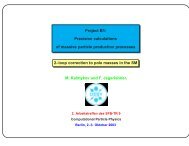Preprint[pdf] - HU Berlin
Preprint[pdf] - HU Berlin
Preprint[pdf] - HU Berlin
You also want an ePaper? Increase the reach of your titles
YUMPU automatically turns print PDFs into web optimized ePapers that Google loves.
Contents<br />
1 Introduction 2<br />
1.1 History 6<br />
1.2 Muon Properties 8<br />
1.3 Lepton Magnetic Moments 11<br />
2 The Muon g − 2 Experiments 13<br />
2.1 The Brookhaven Muon g − 2 Experiment 13<br />
2.2 Summary of Experimental Results 18<br />
3 QED Prediction of g − 2 19<br />
3.1 Universal Contributions 21<br />
3.2 Electron Anomalous Magnetic Moment and the Fine Structure Constant 25<br />
3.3 Mass Dependent Contributions 27<br />
4 Hadronic Vacuum Polarization Corrections 38<br />
4.1 Lowest Order Vacuum Polarization Contribution 40<br />
4.2 Higher Order Hadronic Vacuum Polarization Corrections 52<br />
5 Hadronic Light-by-Light Scattering Contribution 56<br />
5.1 Pseudoscalar–exchange Contribution 61<br />
5.2 Summary of the Light-by-Light Scattering Results 73<br />
5.3 An Effective Field Theory Approach to Hadronic Light-by-Light Scattering 78<br />
6 Electroweak Corrections 80<br />
6.1 1-loop Contribution 80<br />
6.2 2-loop Contribution 81<br />
6.3 2–loop electroweak contributions to ae 93<br />
7 Muon g-2: Theory versus Experiment 95<br />
7.1 Standard Model Prediction 95<br />
7.2 New Physics Contributions 97<br />
8 Outlook and Conclusions 119<br />
8.1 Future Experimental Possibilities 119<br />
8.2 Theory: Critical Assessment of Theoretical Errors and Open Problems 120<br />
8.3 Conclusions 123<br />
A Some Standard Model parameters, ζ values and polylogarithms 124<br />
References 126<br />
1. Introduction<br />
The electron’s spin and magnetic moment were evidenced from the deflection of atoms in an inhomogeneous<br />
magnetic field and the observation of the fine structure by optical spectroscopy [1,2]. Ever since, magnetic<br />
moments and g–values of particles in general and the g − 2 experiments with the electron and the muon<br />
in particular, together with high precision atomic spectroscopy, have played a central role in establishing<br />
the modern theoretical framework for particle physics. That is relativistic quantum field theory in general<br />
and quantum electrodynamics in particular, the prototype theory which developed further into the so called<br />
“Standard Model” (SM) of electromagnetic, weak and strong interactions based on a local gauge principle<br />
and spontaneous symmetry breaking. The muon g −2 is one of the most precisely measured and theoretically<br />
best investigated quantities in particle physics. Our interest in very high precision measurements is motivated<br />
by our eagerness to exploit the limits of our present understanding of nature and to find effects which cannot<br />
be explained by the established theory. More than 30 years after its invention this is still the SM of elementary<br />
particle interactions, a SU(3)c ⊗ SU(2)L ⊗ U(1)Y gauge theory broken to SU(3)c ⊗ U(1)em by the Higgs<br />
mechanism, which requires a not yet discovered Higgs particle to exist.<br />
Designed to be a local, causal and renormalizable quantum field theory, quarks and leptons are allowed<br />
to come only in families in order to be anomaly free and not to conflict with renormalizability. So we have<br />
as the first family the quark doublet (u, d) of the up and down quarks accompanied by the lepton doublet<br />
(νe, e − ) with the electron neutrino and the electron, with the left-handed fields in the doublets and all their<br />
right-handed partners in singlets. All normal matter is made up from these 1st family fermions.<br />
Most surprisingly a second and even a third quark–lepton family exist in nature, all with identical quantum<br />
numbers, as if nature would repeat itself. The corresponding members in the different families only differ<br />
by their mass where the mass scales span an incredible range, from mνe < ∼ 10−3 eV for the electron neutrino<br />
2


![Preprint[pdf] - HU Berlin](https://img.yumpu.com/3833433/2/500x640/preprintpdf-hu-berlin.jpg)




